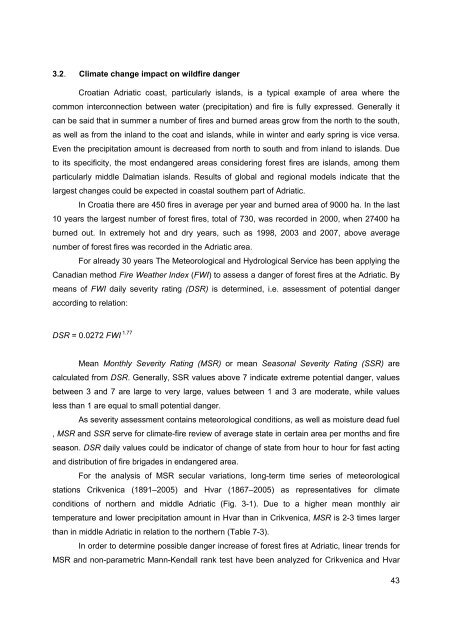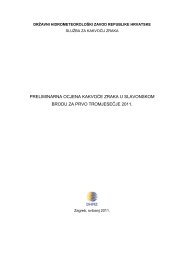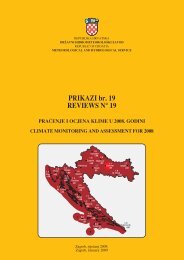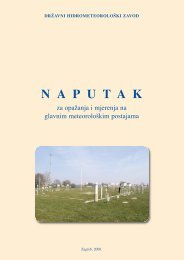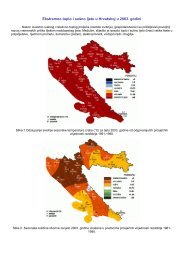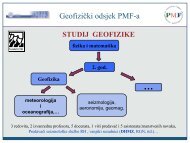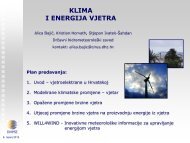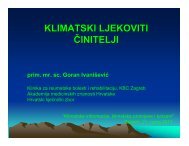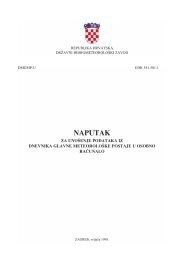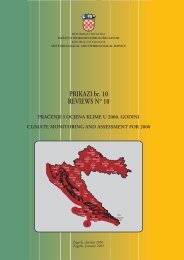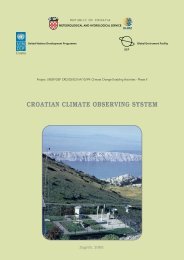Observed climate changes in Croatia Climate change scenario
Observed climate changes in Croatia Climate change scenario
Observed climate changes in Croatia Climate change scenario
Create successful ePaper yourself
Turn your PDF publications into a flip-book with our unique Google optimized e-Paper software.
3.2. <strong>Climate</strong> <strong>change</strong> impact on wildfire danger<br />
<strong>Croatia</strong>n Adriatic coast, particularly islands, is a typical example of area where the<br />
common <strong>in</strong>terconnection between water (precipitation) and fire is fully expressed. Generally it<br />
can be said that <strong>in</strong> summer a number of fires and burned areas grow from the north to the south,<br />
as well as from the <strong>in</strong>land to the coat and islands, while <strong>in</strong> w<strong>in</strong>ter and early spr<strong>in</strong>g is vice versa.<br />
Even the precipitation amount is decreased from north to south and from <strong>in</strong>land to islands. Due<br />
to its specificity, the most endangered areas consider<strong>in</strong>g forest fires are islands, among them<br />
particularly middle Dalmatian islands. Results of global and regional models <strong>in</strong>dicate that the<br />
largest <strong><strong>change</strong>s</strong> could be expected <strong>in</strong> coastal southern part of Adriatic.<br />
In <strong>Croatia</strong> there are 450 fires <strong>in</strong> average per year and burned area of 9000 ha. In the last<br />
10 years the largest number of forest fires, total of 730, was recorded <strong>in</strong> 2000, when 27400 ha<br />
burned out. In extremely hot and dry years, such as 1998, 2003 and 2007, above average<br />
number of forest fires was recorded <strong>in</strong> the Adriatic area.<br />
For already 30 years The Meteorological and Hydrological Service has been apply<strong>in</strong>g the<br />
Canadian method Fire Weather Index (FWI) to assess a danger of forest fires at the Adriatic. By<br />
means of FWI daily severity rat<strong>in</strong>g (DSR) is determ<strong>in</strong>ed, i.e. assessment of potential danger<br />
accord<strong>in</strong>g to relation:<br />
DSR = 0.0272 FWI 1.77<br />
Mean Monthly Severity Rat<strong>in</strong>g (MSR) or mean Seasonal Severity Rat<strong>in</strong>g (SSR) are<br />
calculated from DSR. Generally, SSR values above 7 <strong>in</strong>dicate extreme potential danger, values<br />
between 3 and 7 are large to very large, values between 1 and 3 are moderate, while values<br />
less than 1 are equal to small potential danger.<br />
As severity assessment conta<strong>in</strong>s meteorological conditions, as well as moisture dead fuel<br />
, MSR and SSR serve for <strong>climate</strong>-fire review of average state <strong>in</strong> certa<strong>in</strong> area per months and fire<br />
season. DSR daily values could be <strong>in</strong>dicator of <strong>change</strong> of state from hour to hour for fast act<strong>in</strong>g<br />
and distribution of fire brigades <strong>in</strong> endangered area.<br />
For the analysis of MSR secular variations, long-term time series of meteorological<br />
stations Crikvenica (1891–2005) and Hvar (1867–2005) as representatives for <strong>climate</strong><br />
conditions of northern and middle Adriatic (Fig. 3-1). Due to a higher mean monthly air<br />
temperature and lower precipitation amount <strong>in</strong> Hvar than <strong>in</strong> Crikvenica, MSR is 2-3 times larger<br />
than <strong>in</strong> middle Adriatic <strong>in</strong> relation to the northern (Table 7-3).<br />
In order to determ<strong>in</strong>e possible danger <strong>in</strong>crease of forest fires at Adriatic, l<strong>in</strong>ear trends for<br />
MSR and non-parametric Mann-Kendall rank test have been analyzed for Crikvenica and Hvar<br />
43


